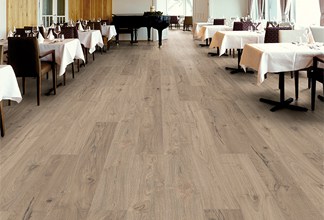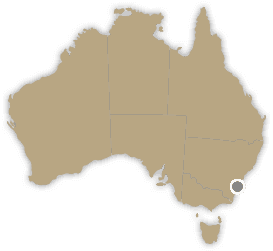
Powered by Google - 5.0 Star Services
5/5

A laminate floor is a layered floor built around a watertight, glued High Density Fibre (HDF) board. All Quick-Step laminate floors consist of four different layers
Until recently, Quick-Step didn’t have laminate floors that were suitable for use in damp rooms such as bathrooms. But this has changed with the introduction of ‘Hydroseal’ technology. ‘Hydroseal’ is an innovative, water-repellent coating that prevents water from entering the floor’s grooves, thus making it perfectly suitable for wet environments, including bathrooms. So yes, laminate is now also a valid – and stylish – flooring option for your bathroom; just make sure to pick a floor with ‘Hydroseal’ technology.
Yes, you can. Quick-Step Laminate floors have a scratch and wear resistant ‘Scratch Guard’ surface layer, making them a perfect choice for your kitchen as well.
Because of the highly moisture resistant HDF core board, an accident with a glass of water falling on the floor for example is not a problem. It is however recommended to remove any standing moisture as soon as reasonably possible.
Of course, the Laminate floor in your kitchen will have to be cleaned more frequently and more intensively than in some other rooms of your house. However, there’s no need to wash the floor; in fact, this should never be done. The sealed surface structure prevents dirt and dust from attaching to the floor. Usually, dry cleaning with Quick-Step microfiber tissues is sufficient.
Floors with bevelled edges must be vacuumed first. Occasionally the floor can be cleaned with a damp or slightly moist Quick-Step microfiber mop using Quick-Step cleaning product in the cleaning water.
Yes, you can. Make sure to install a suitable Quick-Step underlay (with built-in moisture barrier) under the floor and provide sufficiently large expansion gaps so that the installed floor can freely move under the skirting boards. Also avoid standing water or other liquids on the floor, and put suitable doormats outside to collect dirt. Colour fading due to exposure of sunlight is not to be expected.
You can easily cover your stairs with Quick-Step Laminate using the the Quick-Step Incizo profile. The only condition is that the steps of your staircase must be straight and not rounded.
Yes, this is possible. The exact installation method depends on which floor you want to install your laminate
First remove any damp-porous floor covering (i.e. carpet, needle felt, etc.) before installing the Quick-Step Laminate.
ON A DAMP-SEALER FLOOR COVERING
Damp-sealed floor covering (PV, linoleum, VCT, etc.) doesn’t have to be removed but a Quick-Step levelling underlay should be installed.
When you have a wooden subfloor, you have to remove every existing floor covering first.
Important:
When you have an uneven timber floor, you must install the Quick-Step underlay Thermolevel. Also, there must be sufficient ventilation in the crawl space underneath the timber floor. The moisture content of the wood must not exceed 10%. Install the new floor at ninety degrees to the existing subfloor.
Yes. However, it’s necessary to take a few protective measures.
Use soft castors. Most of today’s office chairs can be ordered with soft or hard castors. Soft castors typically have an outside layer of different material and colour (usually light grey). For existing chairs with hard castors, contact your supplier to order soft wheels to replace the hard ones. Soft castors will considerably extend the lifetime of your Laminate flooring. An additional benefit is also that soft castors on a hard floorcoverings such as Laminate will also considerably increase the sitting comfort.
Additionally, you can put a transparent protective mat under your office chairs. Choose a mat for hard floor coverings without profiling on the back. Make sure that the area is big enough. In case of intensive castor chair traffic the combination of soft castors and a protective mat is strongly advi
Quick-Step timber floors are engineered wood floors made up of three layers of solid wood, covered with a protective finish. Thanks to the careful selection of raw material and a perfect control of the moisture content of the wood during the manufacturing process, hardwood floors guarantee optimum stability and durability.
Quick-Step Timber flooring is an engineered timber floor. It means it is made up of three layers of real wood, compared to one layer for solid wood floors. Thanks to the careful selection of raw materials and a sophisticated manufacturing process, engineered hardwood is significantly less sensitive to contracting and expanding than solid wood floors.
| Quick-Step engineerd timber floors | Solid wood floors | |
| Ecology | More economical use of wood: 1 m³ of wood = 150 m² of Quick-Step Parquet Hevea wood = recycled rubber wood (a more solid basis) | 1 m³ of wood = 50 m² solid wood |
| Stability | Consists of 3 layers = less contracting/expanding | A lot of contracting/expanding |
| Lifespan | Top layer = 3 mm: sanding possible up to 3 mm | Sanding: only possible down to the tongue of the plank |
| Installation | Possible to install yourself thanks to the Uniclic Multifit system. Both floating and glue-down installation possible. | Traditional tongue and groove installation is time consuming. Only glue-down installation. |
| Protection | No extra protection needed thanks to 7 layers of varnish. | Needs to be sanded first: oil, varnish and wax. |
| Maintenance | Thanks to the use of dirt-repelling laquer, Quick-Step Parquet is easy to maintain with a simple cleaning kit. | Regular waxing and oiling. |
| Installation time | Product + installation = immediately ready for use. | Product + installation + finishing (sanding and oiling, wax or varnish) |
You can easily cover your stairs with Quick-Step timber flooring using the the Quick-Step Incizo profile. The only condition is that the steps of your staircase must be straight and not rounded.
From a technical point of view, any direction is possible: you can install the planks both lengthwise and widthwise. The choice is purely a matter of personal taste.
As a general rule, you will obtain the most attractive effect if you lay the floor in the same direction as the main light source and in the same line as the most frequently used entrance. However, if there are several doors and windows in the room, you can opt for the direction that facilitates the actual installation.
Quick-Step timber flooring – with the exception of ReadyFlor Blackbutt and Spotted Gum 1, 2 and 3 strip – can be combined with ‘low temperature’ underfloor heating. However, it is absolutely necessary to follow the technical instructions.
There are two ways to lay your floor: floors can either be glued down or laid ‘floating’. Please note that compared to a glued installation, the thermal transmittance and efficiency of a floating floor is slightly lower.
Yes, Quick-Step vinyl floors are highly water resistant. This means they can be used in environments that are occasionally wet, such as your bathroom. Moreover, Quick-Step vinyl floors are cosy and warm, and very soft: you’ll love to walk around barefoot.
However, it is not possible to use vinyl flooring in saunas, steam baths, showers and other extremely wet environments.
Yes. Quick-Step vinyl floors can be used with hot-water underfloor heating systems, underfloor cooling, or a combination of both. Be sure to use the appropriate Quick-Step underlay and always follow the installation guidelines for underfloor heating and cooling. Contact your dealer if you have any doubts.
Quick-Step Luxury Vinyl Tiles can be installed anywhere inside your home or commercial space. However, we do not recommend laying a vinyl floor in extremely wet areas such as showers or pool areas. Although the Quick-Step vinyl planks are water resistant, moisture could enter between the bevels.
As for rooms with very high temperatures: tests have shown that Quick-Step vinyl offers the best dimensional stability on the market. In conservatories and near big, north-facing windows, however, we recommend using a SUN/HEAT underlay.
The answer is yes! A special partnership with Mapei has enabled Quick-Step to offer vinyl flooring solutions that have been extensively tested in a range of floor and wall covering applications.
As cutting vinyl planks can be dangerous, we strongly recommend using the knives and cutting tool provided by Quick-Step. These do not bend under pressure. Moreover, the concave blade prevents the knife from being caught into the structure of the floor, while the cutting tool protects your hands.
Difficult patterns can be cut with a jigsaw (décor up). Always wear protective gloves when cutting Luxury Vinyl Tiles.
Unfortunately, yes. The planks themselves are waterproof, but liquids can seep through the bevels. Water spillage such as in bathrooms and kitchens, however, won’t damage your floor. Also avoid cleaning your vinyl floors with excessive amounts of water and make sure no liquid sits on the floor for too long.
Class 31, 32, 33, etc., refers to a general classification system used for flooring made of carpet, vinyl, laminate, parquet, ceramic tiles, etc. The classification system roughly defines what type of room each floor can be used in. Class 32, for instance, signifies that the floors in this class can be used for moderate commercial use, while class 33 signifies heavy commercial use.
The standard specifies that the flooring product will serve at least 10 years without presenting problems if used in the designated room type, and on the condition that the floor has been installed according to the instructions and is used and maintained as prescribed. For laminate floors, the applicable standard is EN 13329. For vinyl floors, different standards apply, depending on whether a glued-down or click installation method is used:



We had our floating floor installed by the the team at thrust floors and had no problems it’s over 5 yrs old now and we have no complaints.
Scott F
Sydney, Australia


7:00 AM– 4:00 PM
8:30 AM - 2:00 PM
Closed